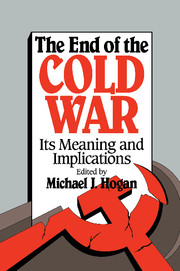Book contents
- Frontmatter
- Contents
- Preface
- The Authors
- Dedication
- 1 Introduction
- 2 An End to Which Cold War?
- 3 The Cold War, the Long Peace, and the Future
- 4 Quiet Cataclysm: Some Afterthoughts on World War III
- 5 Some Lessons from the Cold War
- 6 Nuclear Weapons and European Security during the Cold War
- 7 Victory in the Postwar Era: Despite the Cold War or Because of It?
- 8 The Wicked Witch of the West is Dead. Long Live the Wicked Witch of the East
- 9 The End and the Begining
- 10 A Balance Sheet: Lippmann, Kennan, and the Cold War
- 11 Why Did the Cold War Arise, and Why Did It End?
- 12 A View from Below
- 13 The End of the Cold War and the Middle East
- 14 The End of the Cold War in the Near East: What It Means for Historians and Policy Planners
- 15 After the Cold War: The United States, Germany, and European Security
- 16 The End of the Cold War: A Skeptical View
- 17 The End of the Cold War, the New Role for Europe, and the Decline of the United States
- 18 The Fading of the Cold War—and the Demystification of Twentieth-Century Issues
- 19 The U.S. Government, a Legacy of the Cold War
- 20 Foreign Policy, Partisan Politics, and the End of the Cold War
- 21 Beyond Bipolarity in Space and Time
- 22 A Usable Past for the Future
- Selective Bibliography
- Index
6 - Nuclear Weapons and European Security during the Cold War
Published online by Cambridge University Press: 18 December 2009
- Frontmatter
- Contents
- Preface
- The Authors
- Dedication
- 1 Introduction
- 2 An End to Which Cold War?
- 3 The Cold War, the Long Peace, and the Future
- 4 Quiet Cataclysm: Some Afterthoughts on World War III
- 5 Some Lessons from the Cold War
- 6 Nuclear Weapons and European Security during the Cold War
- 7 Victory in the Postwar Era: Despite the Cold War or Because of It?
- 8 The Wicked Witch of the West is Dead. Long Live the Wicked Witch of the East
- 9 The End and the Begining
- 10 A Balance Sheet: Lippmann, Kennan, and the Cold War
- 11 Why Did the Cold War Arise, and Why Did It End?
- 12 A View from Below
- 13 The End of the Cold War and the Middle East
- 14 The End of the Cold War in the Near East: What It Means for Historians and Policy Planners
- 15 After the Cold War: The United States, Germany, and European Security
- 16 The End of the Cold War: A Skeptical View
- 17 The End of the Cold War, the New Role for Europe, and the Decline of the United States
- 18 The Fading of the Cold War—and the Demystification of Twentieth-Century Issues
- 19 The U.S. Government, a Legacy of the Cold War
- 20 Foreign Policy, Partisan Politics, and the End of the Cold War
- 21 Beyond Bipolarity in Space and Time
- 22 A Usable Past for the Future
- Selective Bibliography
- Index
Summary
The surprise that all students of the Cold War felt when the Berlin Wall was breached on 9 November 1989 remains a vivid memory. Other surprises followed as we came to know more about the socities that had existed behind the Iron Curtain. A surprise that has been widely commented upon was the hollow quality of the Communist regimes, such as those in the German Democratic Republic (GDR) and in Czechoslovakia, that had appeared from the Western perspective to be so solid. Not only did these regimes collapse quickly but it also became apparent, and was in itself surprising, that their economies had been highly dysfunctional. Some officials within the Communist states realized the seriousness of their economic problems. But in the absence of market prices and interaction with market economies to test how these systems really functioned, outside analysts consistently overestimated the productivity of all of the member states of the Council for Mutual Economic Assistance (COMECON). More surprising was the fact that the Soviet military and the leadership of the Soviet Communist party allowed the governments of Eastern Europe to be overthrown when it could be clearly forecast that one result would be the forced withdrawal of Soviet troops from the former satellites. It is now reasonably clear that as the revolutions of 1989 gained momentum, Mikhail Gorbachev and some of his close advisers came to accept this result, just as it is equally clear that the vast majority of the Soviet military, the leadership of the Communist party, and the KGB (Committee of State Security) did not want to relinquish control of Eastern Europe.
- Type
- Chapter
- Information
- The End of the Cold WarIts Meaning and Implications, pp. 63 - 76Publisher: Cambridge University PressPrint publication year: 1992



